Proinflammatory actions of glucocorticoids: glucocorticoids and TNFα coregulate gene expression in vitro and in vivo
- PMID: 22673229
- PMCID: PMC3404340
- DOI: 10.1210/en.2012-1020
Proinflammatory actions of glucocorticoids: glucocorticoids and TNFα coregulate gene expression in vitro and in vivo
Abstract
Synthetic glucocorticoids are widely used for treatment of many inflammatory diseases. However, long-term glucocorticoid treatment can cause a variety of negative side effects. A genome-wide microarray analysis was performed in human lung A549 cells to identify genes regulated by both the antiinflammatory steroid dexamethasone (Dex) and the proinflammatory cytokine TNFα. Unexpectedly, we discovered that numerous genes were coregulated by treatment with both Dex and TNFα. We evaluated the mechanism of coregulation of one of these genes, serpinA3 (α-1 antichymotrypsin), a secreted, acute phase protein strongly associated with numerous inflammatory diseases. Up-regulation of serpinA3 requires the presence of both the glucocorticoid receptor and TNFα soluble receptor 1. Treatment with Dex or TNFα resulted in a 10- to 25-fold increase of serpinA3 mRNA, whereas coadministration of Dex and TNFα led to a synergistic increase in serpinA3 mRNA. The naturally occurring glucocorticoid, cortisol, also resulted in a synergistic increase in serpinA3 mRNA levels in A549 cells. Furthermore, in vivo treatment of C57BL/6 mice with Dex and TNFα resulted in coregulation of serpinA3 mRNA levels in both lung and liver tissues. Finally, chromatin immunoprecipitation analyses suggest that glucocorticoid receptor binding to the serpinA3 transcriptional start site can be enhanced by the combination of Dex plus TNFα treatment of A549 cells. These studies demonstrate that glucocorticoids and proinflammatory compounds can coregulate genes associated with human disease. This discovery may underlie the basis of some of the adverse effects associated with long-term glucocorticoid therapy.
Figures
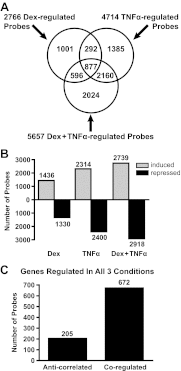
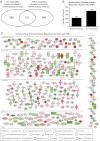

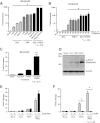
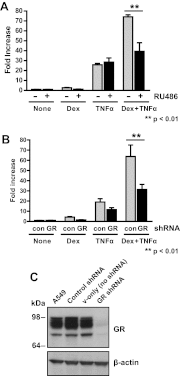
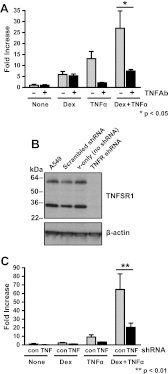
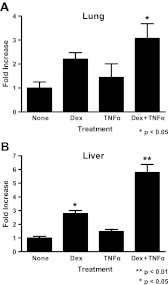

Similar articles
-
Endothelial cells present an innate resistance to glucocorticoid treatment: implications for therapy of primary vasculitis.Ann Rheum Dis. 2012 May;71(5):729-36. doi: 10.1136/annrheumdis-2011-200530. Epub 2011 Dec 27. Ann Rheum Dis. 2012. PMID: 22203687
-
Tumor necrosis factor alpha decreases, and interleukin-10 increases, the sensitivity of human monocytes to dexamethasone: potential regulation of the glucocorticoid receptor.J Clin Endocrinol Metab. 1999 Aug;84(8):2834-9. doi: 10.1210/jcem.84.8.5931. J Clin Endocrinol Metab. 1999. PMID: 10443688
-
CD38 expression is insensitive to steroid action in cells treated with tumor necrosis factor-alpha and interferon-gamma by a mechanism involving the up-regulation of the glucocorticoid receptor beta isoform.Mol Pharmacol. 2006 Feb;69(2):588-96. doi: 10.1124/mol.105.019679. Epub 2005 Nov 16. Mol Pharmacol. 2006. PMID: 16291871
-
The Role of Glucocorticoids in Breast Cancer Therapy.Curr Oncol. 2022 Dec 25;30(1):298-314. doi: 10.3390/curroncol30010024. Curr Oncol. 2022. PMID: 36661673 Free PMC article. Review.
-
Possible roles for glucocorticoid signalling in breast cancer.Mol Cell Endocrinol. 2018 May 5;466:38-50. doi: 10.1016/j.mce.2017.07.004. Epub 2017 Jul 4. Mol Cell Endocrinol. 2018. PMID: 28687451 Review.
Cited by
-
Effect of ApoA4 on SERPINA3 mediated by nuclear receptors NR4A1 and NR1D1 in hepatocytes.Biochem Biophys Res Commun. 2017 May 27;487(2):327-332. doi: 10.1016/j.bbrc.2017.04.058. Epub 2017 Apr 13. Biochem Biophys Res Commun. 2017. PMID: 28412351 Free PMC article.
-
The five Rs of glucocorticoid action during inflammation: ready, reinforce, repress, resolve, and restore.Trends Endocrinol Metab. 2013 Mar;24(3):109-19. doi: 10.1016/j.tem.2012.11.005. Epub 2013 Jan 8. Trends Endocrinol Metab. 2013. PMID: 23312823 Free PMC article. Review.
-
New insights into the cell- and tissue-specificity of glucocorticoid actions.Cell Mol Immunol. 2021 Feb;18(2):269-278. doi: 10.1038/s41423-020-00526-2. Epub 2020 Aug 31. Cell Mol Immunol. 2021. PMID: 32868909 Free PMC article. Review.
-
Impact of downstream effects of glucocorticoid receptor dysfunction on organ function in critical illness-associated systemic inflammation.Intensive Care Med Exp. 2020 Dec 18;8(Suppl 1):37. doi: 10.1186/s40635-020-00325-z. Intensive Care Med Exp. 2020. PMID: 33336296 Free PMC article. Review.
-
Important lessons learned from studies on the pharmacology of glucocorticoids in human airway smooth muscle cells: Too much of a good thing may be a problem.Pharmacol Ther. 2020 Sep;213:107589. doi: 10.1016/j.pharmthera.2020.107589. Epub 2020 May 27. Pharmacol Ther. 2020. PMID: 32473159 Free PMC article. Review.
References
-
- Revollo JR, Cidlowski JA. 2009. Mechanisms generating diversity in glucocorticoid receptor signaling. Ann NY Acad Sci 1179:167–178 - PubMed
-
- Baschant U, Tuckermann J. 2010. The role of the glucocorticoid receptor in inflammation and immunity. J Steroid Biochem Mol Biol 120:69–75 - PubMed
-
- Magnussen H, Watz H. 2009. Systemic inflammation in chronic obstructive pulmonary disease and asthma: relation with comorbidities. Proc Am Thorac Soc 6:648–651 - PubMed
Publication types
MeSH terms
Substances
Grants and funding
LinkOut - more resources
Full Text Sources
Medical
Miscellaneous

